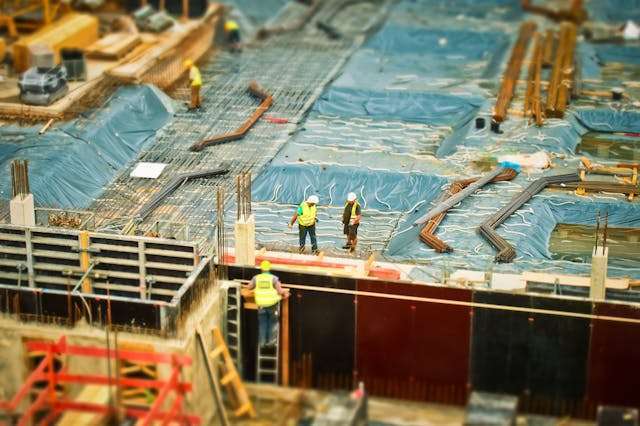Understanding Shoring Agreements in Construction: A Comprehensive Guide
Have you ever wondered how those massive buildings rise up from the ground so confidently? Well, one crucial element behind the scenes is something called a Shoring Agreement. It might sound like construction jargon, but don’t worry – we’re here to unravel it for you in the simplest way possible. In this blog, you will understand everything about shoring agreements.
Understanding Shoring Agreements:
Picture this: when a team of construction workers needs to dig as deep as possible into the earth to support the foundation for a skyscraper or a shopping center, they often hit the limit of what their equipment and expertise can do. If in case the soil’s strength is insufficient to support the shape structure, it can lead to collapses and accidents. This is where the shoring will play a crucial role!
A Shoring Agreement is the exact power link between the project construction firm and the property owner that allows them to secure temporary supportive structures to ensure that everything is leveled up during construction. It’s as though you are building a skyscraper that has a safety net on which you can lean on.
Exploring the Components of a Shoring Agreement:
Permissions and Rights:
- Shoring agreements outline what activities the construction crew is permitted to do on the neighboring property. This refers to undertaking the process such as excavation, putting up shoring systems, or any other construction tasks that are required to be done.
- The rights provided by the agreement ensure that both parties are aware of the plans as well as their consent to the constructions occurring near their properties.
- It must be ensured for both residents and construction companies to define and maintain specific limits and regulations to avoid conflicts or confusion.
Responsibilities:
- Shoring contracts specify the duties of all stakeholders in the on-site construction process.
- The shoring systems are often installed and maintained by the construction department company.
- The property owners can carry out tasks such as giving permission to access their land for construction purposes and avoid their property being affected by activities that go with the construction.
- The demarcation of the roles and responsibilities works well on keeping the conflicts at the lowest level and making sure that all the people concerned stick to their jobs in the project.
Also read: How to Turn the Construction Industry into the Online World
Duration and Termination:
- Shoring contracts, in most cases, denote the span of time for which the shoring systems will remain operational.
- This step includes the description of shoring as a temporary measure that could be removed in some cases, such as at the end of construction work or when specific milestones have been reached.
- Providing the stipulations of the contract such as the duration and manner of termination, is a measure that aims at removing misunderstandings and the process of construction runs smoothly.
Civil Litigation Considerations:
- Shoring agreements are usually formulated to address the expected disagreements or losses that may emerge during the construction process.
- These clauses explain the rules of the court for civil disagreements with the help of arbitration and mediation procedures.
- Incorporating the elements of civil litigation, shoring agreement ensures a fair and transparent dispute resolution process. This way, the rights of all participants are protected, and a cordial working relationship is kept.
Crane Swing Rights:
- For certain construction projects, the use of cranes to move materials over neighboring territories is compatible.
- Usually, the agreements of shoring contain the parts that address the rights as well as the limitations of crane swing operation.
- The regulation states that the landowners must be informed about and consent to the crane swings, which reduces disruptions and conflicts.
- Clear communication and awareness of crane swing rights facilitate the efficient and teamwork-based putting into effect of construction projects.
Why Shoring Agreements Matter:
Safety First:
- The main purpose of the shoring agreements is the safety of the workers and their neighbors above all else. There are risks inherent in the construction process while we carry out excavation and building, mainly when the work involves digging deep in the ground.
- These treaties ensure that all necessary safety procedures are applied in order to reduce the possibility of accidents, collapses, and other dangerous situations.
- Through safety guidelines and procedures, these agreements aim to develop a secure environment for construction workers and nearby residents, which will propagate a safety culture for the entire project.
Legal Protection:
- Shoring agreements provide much-needed legal certainty and safety, plus they establish peace of mind between all the parties engaging in the construction project.
- This is usually done by issuing clear instructions on roles and responsibilities, thereby reducing the chances of dispute and confusion in relation to the project at hand.
- Should unexpected events or conflicts emerge, the implementation of a specifically defined agreement will immensely simplify resolution processes while securing the involvement and participation of all parties in the light of new circumstances.
- Through the policing of legal issues beforehand, shoring agreements will cushion, and in some cases eliminate, the costly litigations and delays, hence contributing to the eventual success of the project.
Community Cooperation:
- Shoring agreements not only encourage communication between the construction company and the owner of the property but also show cooperation, which makes the process transparent.
- Through the involvement of reciprocal talks and discussions, both parties can mutually work out issues, the requirements the parties getting into the agreement should meet, and seek commonality in their interests.
- Developing constructive partnerships and trust between construction workers and the local residents form the basis of successful projects.
- Covenants of this type acknowledge that people nearby reside in this or that local community and, therefore, throughout the period of construction, the interests of all parties involved and their harmonious relations should be heard.
- Community appreciation and promotion of cooperation and engagement are some of the factors that make such agreements fulfill their function and, as a result, preserve the ability of the community to carry on their projects even long after the fulfillment of the initial objective.
Risk Management:
- An agreement about shoring is very useful for risk management in construction projects.
- Outlining responsibilities, protocol, and safety measures, the agreements are the tool that makes it easier to tackle the risks associated with undertakings such as excavation, shoring installation, and other construction operations.
- Risk management that is proactive prevents accidents, destructive destruction, and financial losses through the protection of the common interest of the parties involved.
- The shoring agreements play a central role in identifying risk factors early on and putting in place efficient risk mitigation measures to increase the general success and sustainability of building projects.
Project Coordination:
- Shoring terms of reference provides an effective way to facilitate the implementation of a project by laying down a framework for communication and a platform for teamwork among stakeholders.
- They lay out road and timing maps, will, of course, grant their permission for properties involved, and be the ones to organize the construction work, ensuring project goals are accomplished on time.
- A dedicated communication vacuum, as well as the delineation of roles, is the way forward fundamental to efficient and effective project execution.
- Correspondingly, project management leads to workflow boosting, meeting deadlines restrictions and resource utilization effectiveness that result in successful project completion.
Environmental Considerations:
- Shoring agreements could cover provisions dealing with environmental concerns and adherence to legal regulations.
- Excavation and soil disturbance are the major impacts that construction activities may have on the environment, such as soil erosion, sedimentation, and habitat disruption.
- Shoring agreements may stipulate the implementation of environmental protection measures like erosion control, sedimentation management, and proper disposal of construction waste.
- Through the inclusion of environmental factors in the contract, construction teams show that they take sustainability practices and conservancy into account.
- Adherence to environmental standards not only reduces the level of damage to the environment caused by the project but also improves the project’s image and acceptance in the local community.
Economic Stability:
- Shoring agreements ensure both stability and transparent visualization in construction projects.
- Confidential terms in agreements that specify a contractor’s responsibilities, deadline and costs will help mitigate uncertainties and fluctuations in project expenses.
- The property owners will be satisfied when the agreements are reached in which they are compensated with the set amount of money or benefits for allowing the surveyors to be on their properties.
- Construction companies can efficiently divide their budgets and resources as the shoring contract could outline their responsibilities and limitations to them.
- Economic stability creates investor confidence, runs the creation of sustainable growth, and contributes to the construction industry and the global economy’s stability.
Conclusion:
Finally, and there it is–a thorough walk-through of the shoring agreements in construction! These have become the foundation of the safe and successful realization of a building project, knowing that all stakeholders understand their rights, the fulfillment of their obligations, and the importance of cooperation.
Thus, when you bump into a construction site in the future, you will have a much better understanding of the complex procedures that are involved in its operation. Carry on, keep striving for more, and also, it is likely that you will soon be drafting shoring agreements with the help of your lawyer.





